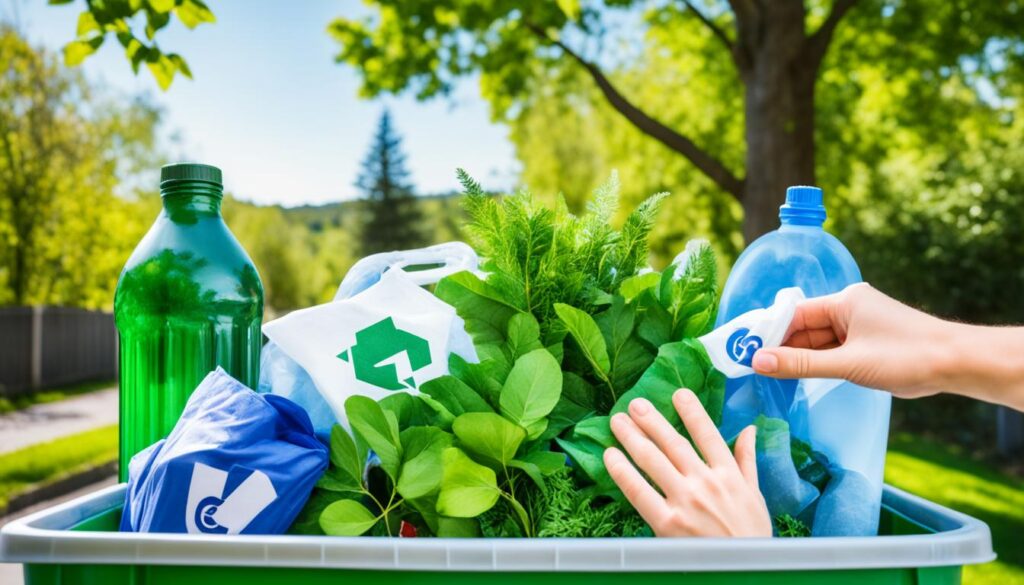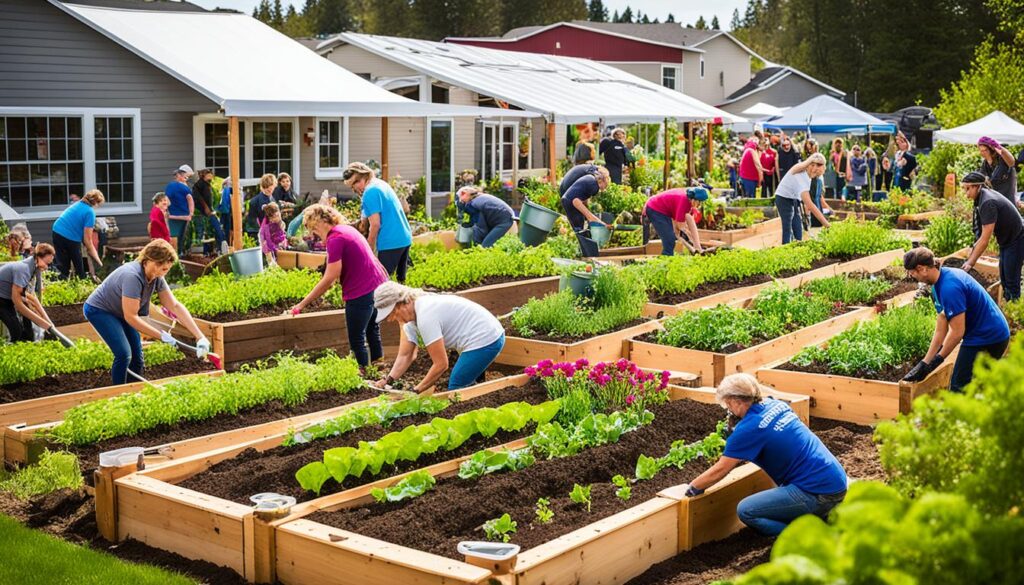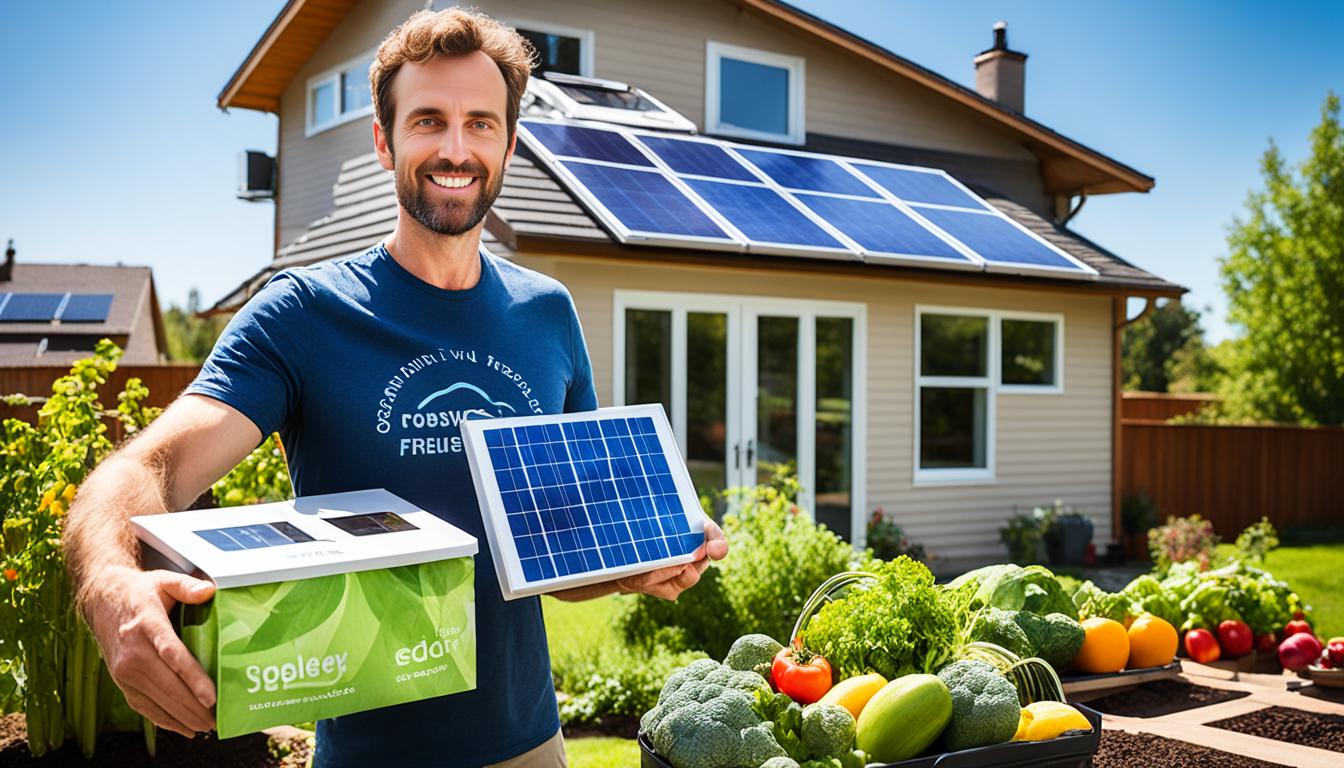I love living in a way that helps the planet. I use sustainable methods and eco-friendly things every day. This helps make the future kinder to the earth. I work hard to lower my carbon footprint and protect nature.
Key Takeaways:
- Environmental impact can be reduced by adopting sustainable practices.
- Minimizing your carbon footprint is crucial for environmental conservation.
- Eco-friendly solutions and green initiatives play a significant role in sustainable development.
- By embracing an eco-friendly lifestyle, we can contribute to a more sustainable future.
- Environmental stewardship is a shared responsibility for a healthier planet.
Understanding Your Carbon Footprint
Your carbon footprint shows how much greenhouse gas you cause with daily activities. This includes direct emissions, like driving, and indirect ones, such as making and disposing of items. You can reduce your impact by choosing green transportation, saving energy, eating wisely, buying eco-friendly goods, and cutting down on waste.
Green your daily travel by carpooling, biking, or using buses and trains. These steps lower the harmful gases your commute produces. Also, save energy at home by turning off lights and other devices when you’re not using them.
“Every small step towards sustainability adds up to a significant impact.” – Jane Goodall
Changing your diet can also help the planet. Eating less meat and more plants cuts down on greenhouse gases. Choosing local and organic foods reduces your food’s environmental impact.
When you shop, pick green items made from sustainable materials. Look for brands that care about the environment and have clear production methods. Your choices can help support eco-friendly practices and a cleaner future.
Reducing waste is vital, too. Try to recycle, compost, and reuse. Say no to single-use plastic and go for things you can use again. This simple step makes a big difference.
Components of a Carbon Footprint
Let’s dive into what makes up your carbon footprint:
| Carbon Footprint Component | Description |
|---|---|
| Transportation | Includes emissions from vehicles used for commuting and traveling |
| Home Energy Use | Includes emissions from electricity and gas consumption in your household |
| Diet | Includes emissions from food production, agriculture, and livestock |
| Shopping | Includes emissions from the production, packaging, and transportation of goods |
| Waste | Includes emissions from the disposal of waste and landfill gases |
Understanding these parts can help you make greener choices. By acting in all these areas, you lower your carbon footprint. This leads to a more planet-friendly lifestyle.
Sustainable Practices to Reduce Carbon Footprint
It’s key to lessen our carbon footprint for a greener future. We must use sustainable ways in our daily routines. This helps fight climate change and keeps the Earth healthy for those who come after us.
Transportation
We can cut back on carbon by changing how we get around. Picking eco-friendly ways like using public transport or biking is great. If you need a car, go for one that’s electric or hybrid. This not only makes our air cleaner but also keeps us healthy.
Home Energy Use
Our home energy use is a big area for improvement. Small changes in our habits can cut a lot of carbon. Swap old appliances for ones that save energy. Using things like solar panels helps, too. When we use less fossil fuel energy, we help the Earth stay green.
Eco-Friendly Diet
What we eat matters for the planet, too. A diet that focuses on plants lowers our carbon impact. It’s also good to buy food grown close by. This lowers how much we pollute and helps farmers who do things the right way. Eating wisely and using up what we have prevents waste.
Sustainable Shopping
Our buying habits can make a difference. Choose products that are good for the Earth. This means looking for local items and those that are well-made. And less packaging is better. By buying smart, we support a healthy economy and protect nature.
Waste Reduction
Less trash is key to helping the planet. Remember: Reduce, Reuse, and Recycle. Avoid items you only use once, like plastic bags. Turn food scraps into compost. And don’t throw away things that still work. Doing this stops pollution and saves resources.

“The greatest threat to our planet is the belief that someone else will save it.”
– Robert Swan
| Practices | Benefits |
|---|---|
| Opting for sustainable transportation | Reduces carbon emissions, promotes a healthier lifestyle |
| Switching to energy-efficient appliances and renewable energy sources | Decreases energy consumption, reduces reliance on fossil fuels |
| Adopting a plant-based diet and choosing locally sourced and organic foods | Minimizes greenhouse gas emissions from animal agriculture, supports sustainable farming practices |
| Practicing sustainable shopping habits | Encourages businesses to adopt greener practices, reduces packaging waste |
| Engaging in waste reduction practices | Prevents pollution, conserves resources |
Engaging in Eco-Friendly Community Initiatives
In an eco-friendly life, we must join with others to help our planet. You can join local green groups, back green policies, and join in community work. This way, we make our collective green dreams come true.
Joining Environmental Groups
Joining a green group can be very impactful. These groups talk about the issues, push for eco-friendly ways, and start projects. Being a member lets you talk with others and work on saving our Earth.
Supporting Sustainability Policies
Backing up green rules helps a lot. Learn about new rules, go to meetings, and send letters to leaders in support. Your voice can help make our world greener.
Volunteering for Community Projects
Helping out in clean-ups or planting trees is great for the Earth. It also makes you feel part of a bigger team. You can meet new friends and learn a lot about our planet.
“Volunteering for community projects not only benefits the environment but also fosters a sense of community and togetherness.”
Offsetting Your Carbon Footprint
You can also balance out your carbon use through special programs. These programs let you take part in projects that cut or take out your carbon waste.
Getting into green projects is not just about you. It’s about making a big change together. This way, we build a world where we and future folks can live well.

Conclusion
Being eco-friendly is important for creating a sustainable future. It means making choices that help our planet. Every small action helps, like using green products and changing how we travel or eat.
SmartLifeco. is a company that shows us better choices. They offer eco-friendly options and teach us why it matters. Supporting brands like SmartLifeco. helps the earth and our future.
Our choices really do matter. Living green helps cut down our impact on the planet. Together, we can make tomorrow better and more eco-friendly for everybody.
FAQ
What is a carbon footprint?
Your carbon footprint shows the amount of greenhouse gases you create. This happens from your daily actions. This includes both direct and indirect sources.
How can I reduce my carbon footprint?
Make sustainable choices in your life. This applies to your way of getting around, using energy, eating, buying things, and managing your waste.
How can I reduce transportation-related emissions?
To cut down on emissions from getting around, choose greener options. This means using public transport, biking, walking, or driving electric or hybrid cars.
What can I do to lower my home energy use?
Lowering your home’s energy use starts with the right appliances. Use renewables, like solar or wind. Also, smart home tech can help a lot.
How can my diet affect my carbon footprint?
Eating more plant-based, local, and organic foods makes a big difference. It cuts down on food’s carbon impact. So does sustainable shopping.
How can I practice waste reduction?
Reduce your waste by recycling, reusing, and avoiding throwaway plastics. This really helps the planet.
How can I get involved in eco-friendly community initiatives?
Join local green groups, help in community gardens, and back green policies. They make a big difference.
What are some ways to support a sustainable future?
Help at clean-up events and plant trees. You can also balance out your own carbon by supporting reliable programs. This fights climate change.




